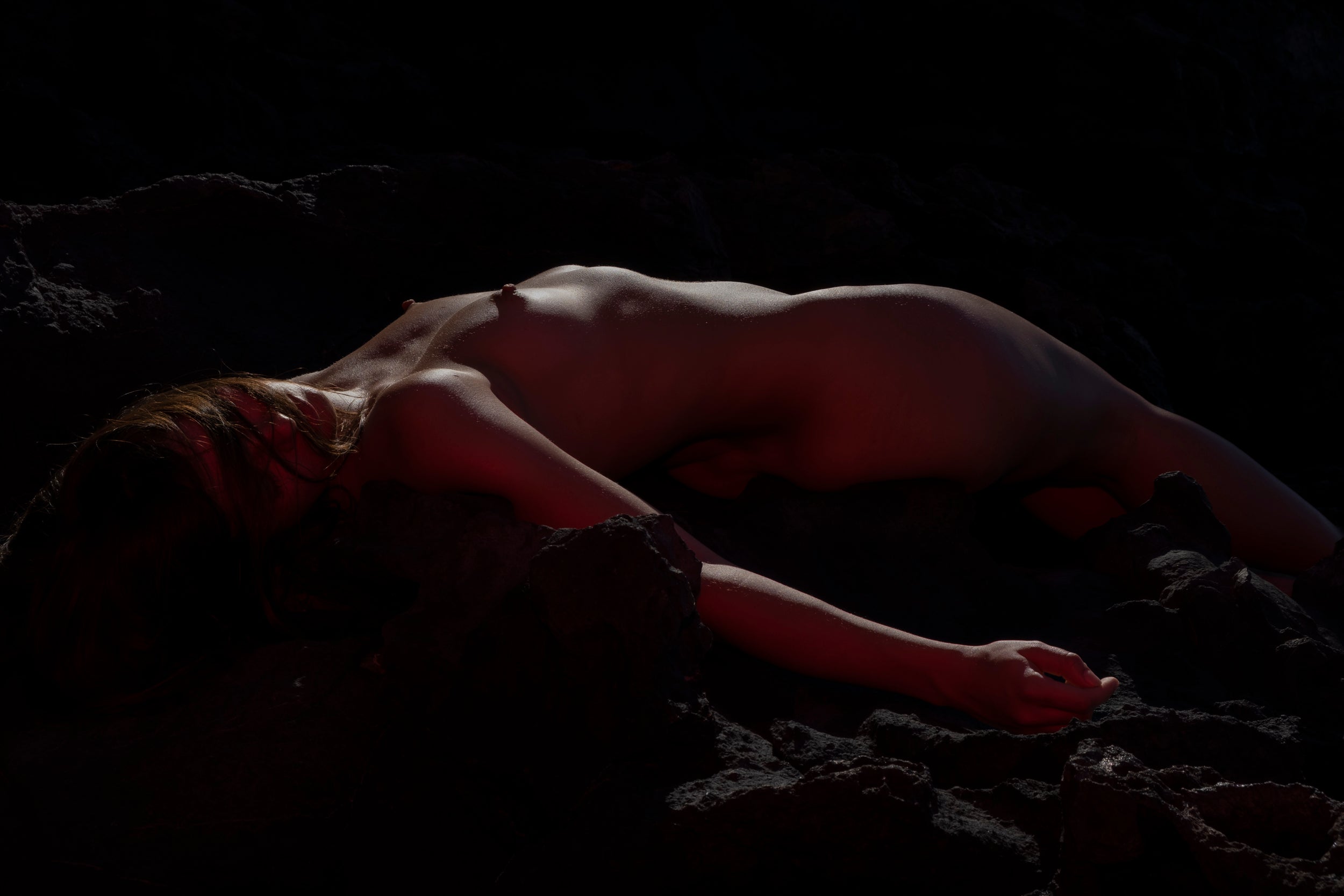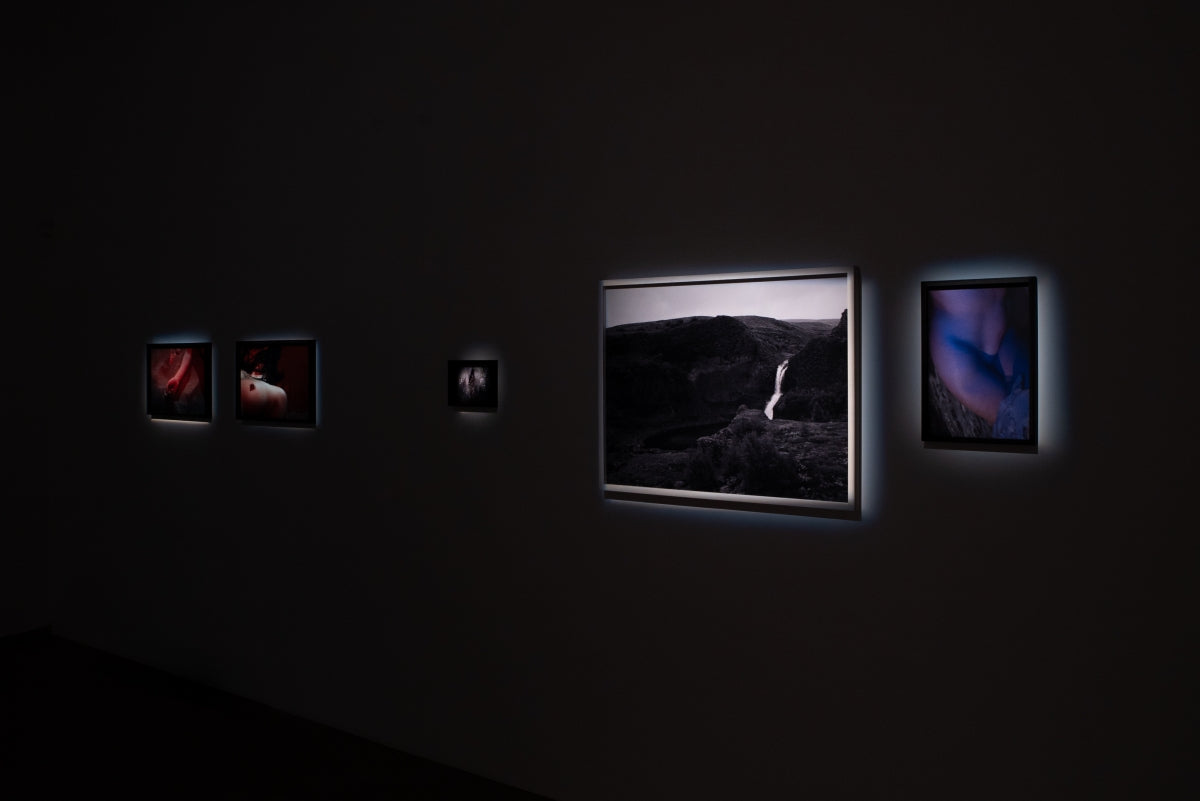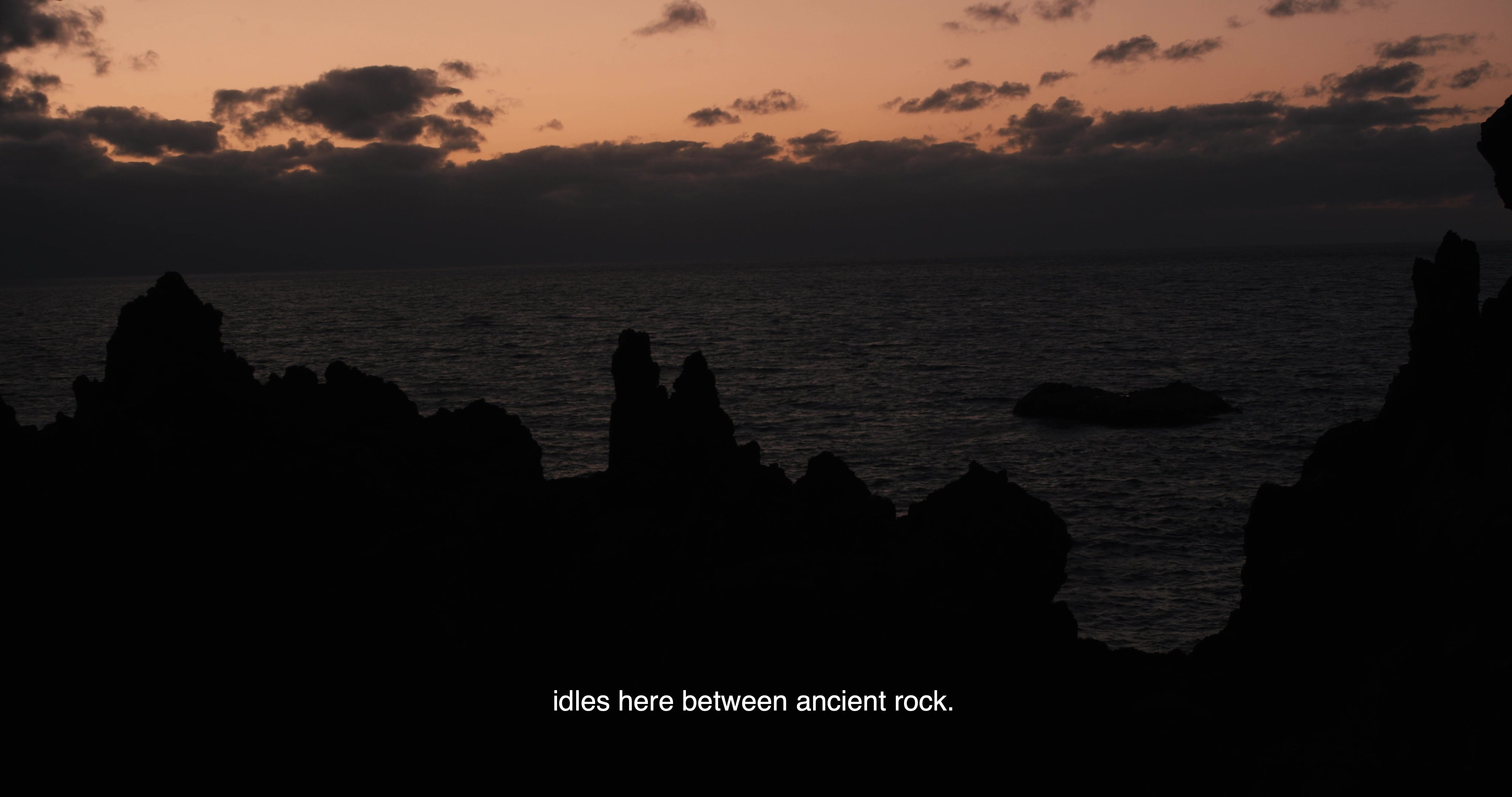"Smooth Space, Pleated". Exhibition by Geistė Marija Kinčinaitytė
by Maya Hristova
·
‘I do not know what shadowy oils anoint our idea of our body. Our weariness is the mere shadow of a weariness. It comes to us from far away, like our idea of having a life... ’
Fernando Pessoa, The Book of Disquiet
‘smooth space, pleated’ | Exhibition Review
What first strikes the eye when you enter Geistė Marija Kinčinaitytė’s ‘smooth space, pleated’ at Vartai Gallery in Vilnius is that the artist meticulously crafts the integral atmosphere of the display. It entraps you like your own fears and loves, shame and longing. Kinčinaitytė’s work seems to be most at home precisely in this chamber solo show genre, which gives the convenience of terraforming coherent sensual landscapes of peculiar chromatic and sonic palettes. In this show, the landscape extends over two of the gallery’s halls, one of which contains fourteen neatly lit photographic exposures emerging from the dark and the other a video essay entitled ‘The Pool’ (2020), made in collaboration with the experimental composers Simon Allen, Jan Hendrickse, and Sandro Mussida, as well as the writer Elaine Tam, who is also the curator of the whole exhibition.

Burning
Sustaining the paradox between the show title and the narrow dark rooms, Kinčinaitytė plays with the categories of close and distant, familiar and foreign. The themes of the (foreign) body and alienation dominate this exhibition and the artist’s most recent research. Even though the parallel of the body as landscape (and vice versa) may seem trite and self-evident, Kinčinaitytė wraps it in her distinctive aesthetic awash with angst and the uncanny. Motifs migrating from show to show demonstrate the artist’s consistency and sensitivity to visual ant thematic halftones. One may notice how each of the exhibitions begins to flirt with the preceding one, images comment on other images, and the entire oeuvre weaves a continuous text which could be classified according to Roland Barthes’ typology as jouissance – uncomfortable and disturbing dizziness, suspended release of pleasure. Kinčinaitytė’s stories are exactly this: elemental, levitating between eros and thanatos, pleated over and over again.

Shore
Pleats, posterotics and neon red arrive here from her show ‘The Eyes Are Most Sensitive to Red’ held at the Sodų 4 project space in Vilnius just a few years ago. Meanwhile, the Martian landscape’s submission to the human gaze which Kinčinaitytė analysed in the project ‘You Belong to Me’ is reversed in the current exhibition. This time the artist observes the Earth and the human with a nonhuman Other’s gaze. The intimacy and communication that are the objects of her ongoing research noticeably acquire another scale and distance here, evolving into a desire of a totally different kind. The bodies in the photographs become integral folds of the landscape, visually concurring with the clotted waterfalls or withered volcanic peaks. The artist directs our gaze in such a way that the images before our eyes look like vaguely reminiscent yet unrecognisable postcards of a deserted Earth and abandoned bodies, inclusions of terrestrial memory. The longer you look, the more poignant and wistful they become.

Passage
This odd feeling of longing for home while being at home is known by the name of solastalgia. A combination of the Latin word sōlācium (comfort) and the Greek root -algia (pain), the neologism was coined in 2005 by the philosopher Glenn Albrecht. Solastalgia describes emotional discomfort caused by the changing environment, particularly the shifts triggered by the global climate change which disturb the sense of familiarity with a place. Making ‘home’ the surface of the Earth and our own bodies, Kinčinaitytė induces this feeling through subtle gestures – not by depicting an altered environment but by manipulating our position as viewers, changing us and attempting to persuade us into being and seeing as the Other. The artist’s exhibition illustrates that images of devastated surfaces are not necessary to convey a sense of extinction, and that ‘a piece of landscape that looks beautiful can become the opposite of beauty,’ to quote the American filmmaker James Benning.
The notion of solastalgia could frame the entire atmosphere of ‘smooth space, pleated’, yet it manifests itself in a still different way in the video essay ‘The Pool’. The latter unfolds a very obsessive and compulsive erotic narrative woven from static landscapes of the Canary islands, the ocean licking the shore, and hunchbacked coastal cliffs. As if searching for signs of life, the artist explores both the ‘outside’ and the ‘inside’ of the landscape. The accompanying text is an unanswered sofisticated poetic letter to sublime landscapes. They care about a relationship with us as much as they do about a volcanic eruption or a flood. The artist transposes nature’s indifference and foreignness to humans onto us, asking where this feeling begins and ends when we consider ourselves. Where do our human feelings as well as bodies begin and end? Does human necessarily mean terrestrial, and vice versa?

Fold
Bringing alienation to the foreground in the video essay, Kinčinaitytė reminds us of the relevance of this relation. Exactly, relation. Alienation is said to be a modern malaise caused by secularisation, urbanisation, radical individualisation, technology, even helplessness in the face of the major climate change. Yet first and foremost it is a cooled relation with the environment and oneself. Not an absence of relation, but a relation of relationlessness, as the philosopher Rahel Jaeggi puts it. Seeking to illustrate it in our global anthropocentric relation with the Earth’s landscapes, the artist evokes much smaller-scale relations of relationlessness, all the Others and otherness which we still often turn a blind eye to and perhaps do not long for at all.
Exhibition review by Jogintė Bučinskaitė. Courtesy of echo gone wrong

Wound
'The Pool' | Publication
Interweaving theory and fiction, 'The Pool' is a tripartite piece of performance writing comprising Sessions, Diagrams and Afterword. Sessions takes the form of transcribed interviews charting a series of shore-side events, as it is recounted by an unidentified Narrator. In its relationship to departure the shore is a demarcation; a place where the classical, idealised voyage must risk subversion by Derrida's unforeseen counterpart: the arrivant.

'The Pool' (publication) | Text by Elaine Tam | Design by Eva Mozaz | Images by Geistė Marija Kinčinaitytė | Diagrams by Arthur Gouillart
Excerpt | Sunday, 2 February 2019 Session #3 Duration: 5 minutes, 44 seconds
When did things “get weird”? {Gestures quotation} I couldn’t quite tell you. It seems odd to begin a session with this type of qualification or determination. (1.1) Oh, I don’t know: in a sudden irruption of forces, the spillage of night terrors into the day. She was stricken by a most disastrous, descendental madness, which others have tried to politely umbrella-term “emotional instability”. What Freud might have declared “hysteria”. But nothing seemed truly apt.
Lost in her hallucinatory throes, we stopped having any regard for the “axioms of social normativity”. And like this, we receded further into the debauched isolation of which my flat reeked, should isolation smell so pungent, distinctly of rotting salmon — Intercepted before it could meet with its destiny — it spends a lifetime crossing salt and fresh water just to return, culminating in a final swim upstream to its birthplace, Sunday, 2 February 2019 Session #3 Duration: 5 minutes, 44 seconds 15 16 to release eggs or die of exhaustion. (1) The Great Salmon Run, ~ I’ll never forget how it brought tears to my eyes. ~ “That is, if not farmed in captivity like most nowadays,” someone once reminded me, quickly dispelling the romanticism with which I recounted Attenborough’s documentary. I last thought of this in the queue at the supermarket, holding some salmon pink with fatty stripes, shiny under cellophane. This sma::ll, packaged weight, “2x 240g fillets”, a facetious commiseration for the teleology of its grander natural ends. Prices were e:specially high in 2017 due to acute outbreaks of sea lice in Scotland and Norway, eating into the “global supply”. (1.2) But her appetite of both kinds had dwindled — much like she didn’t care for me, she didn’t care to eat, and she emphasized her reluctance to these things in stiff and arthritic behaviour. The limbs once lively for me now stultified. (0.6) ~ My feelings were a:ll mixed up with the absent words and those petty peas she’d shove ‘round and ‘round her plate. ~ Then, like a fearful child, she would stash the remains of the day away, leaving behind nothing but a plate licked deceptively clean. The moulting flakes pan-seared, (0.7) putrid and love-sick, stuffed in a series of holes.

Spine
Replaying some anxiety and rage generated at birth — psychic echoes — became the sole preoccupation, the schedule around which our lives would orbit. I was forced to finally confront the issue when the excitations of her harrowing obsession became so extreme that she began to mismanage the etiquette of concealment. So it could no longer be ignored: five dried fingerprints with maroon inlaid, something like a botched woodblock print — grainy and with smudges — moved over the bathroom porcelain in sordid procession. Dead giveaway. Alarmed, I put my face very close to inspect it, like I had done with those Hokusai works at the British Museum — an examination that made the assemblage of fingerprint-blood-porcelain seem similarly well-acquainted mediums. The halcyon sanctuary in the memory of Red Fuji’s washes allowed me to relish a split-second’s comfort. {Swallows} (1.3) I burst out and into the hall. From the bliss of oblivion, to the urge of denial, switching like a live wire. (1.8) She was facing the window with her back turned, bent over, so dishevelled, shirt rucked up — Dog at a flea bite — The woeful light coming through making sharp witness of her agitated movements. A lone black curl on her back quivering, while she plunged her fingers far deeper than they should go into that godforsaken hole — “This is what it’s like to be inside” — And lashes of crimson etched in the raw skin about it — The mutterings — It could not be ignored. I listened; at first nothing but a revolting slurry of incomprehensible garble, then coming, like slowly drawn blood: Out... into this world... this world... tiny little thing... before its time... I spun her around so as to demand explanation, ~ and other things that should have also been long extinguished hopes. ~ She looked up at me with the bewilderment of a guilty child, her sibylline soliloquy interrupted as I brought her face to face with me. {Eyes widen} Those long, sad, dark alien eyes, 17 18 flung open, unsure why — Sargasso Sea, enfolding me into their ghastly blankness, an inhuman emptiness. Something was seriously amiss. They behaved like dispossessed orifices, sinkholes, reaching back and still further back, ever-extending like geological history or the relentless passage of time — Two endless repositories for forgotten pasts in other lives, elsewhere and elsewhen, that had resisted erasure by Lethean natal flows. (0.6) The beady fly on the window pane blinked with its wings, before taking its hum back to flight.
'The Pool' | Video Essay
'smooth space, pleated' is a solo-presentation of new work by Geistė Kinčinaitytė which revolves around the artist's debut film piece — a video essay entitled 'The Pool' loosely based on the short story of the same title. This work is the result of a collaboration with curator-writer Elaine Tam, and experimental composers Simon Allen, Jan Hendreickse and Sandro Mussida. The culmination of a long-standing fascination with the unheimlich, Kinčinaitytė uses image-making to draw out the mesmeric charge of naturally-occurring phenomena: bodies of water, barren lands and interior cavities.

Red Pool

‘smooth space, pleated’ | The Work
The abandoned body, a prominent figure which recurs throughout Kinčinaitytė’s early photographic works, can be understood as a place where the familiar and foreign converge. In her early series The Wake, she resurrects the female nude by rotating the image 90 degrees, an act that transforms the landscape body. Its passive horizontality becomes a sluggish erection, an unnatural suspension invoking the uncanny, revealing the erotic nude as always already a corpse. In 'smooth space, pleated', the landscape becomes this very body in question.
A sense of violence pervades acts of image-making that look to represent or animate that which is perceived as passive — from exposure to the editing cut. In resistance, Kinčinaitytė orients herself towards an alternative means of engaging with a terrestrial subreality. Privileging intuition over knowing, vulnerability over apprehension, this openness itself becomes a site of psychical and physical boundary-crossing. This mutual exchange — a folding — visually figures as the shore and is central to 'The Pool' in literal and metaphoric senses. Symbolic of limit, incursion and threshold, the shore is the site par excellence for incantations of, or encounters with Otherness. The camera that insists on capture discovers that landscapes are agentic, generative bodies, evading fixed explanation and instead appealing to fluid modes of fictioning.

Volcano
'smooth space, pleated' considers the enfolding of different forms of beings and bodies through experiments of a geopoetic nature. Continuing interests developed in Kincinaityte’s previous project 'You Belong to Me' (2015), what begins as documentation soon becomes a sensuous love letter, one shared between human and non-human forces.
Text by Elaine Tam

Touch II

Inside
Geistė Kinčinaitytė is a Lithuanian artist and researcher. She is currently undertaking her PhD in Film and Screen Studies at the University of Cambridge. Her research interests include media archaeology, artists’ films and installations. Her work 'You Belong To Me' was also published as part of eep Vol.1.





















